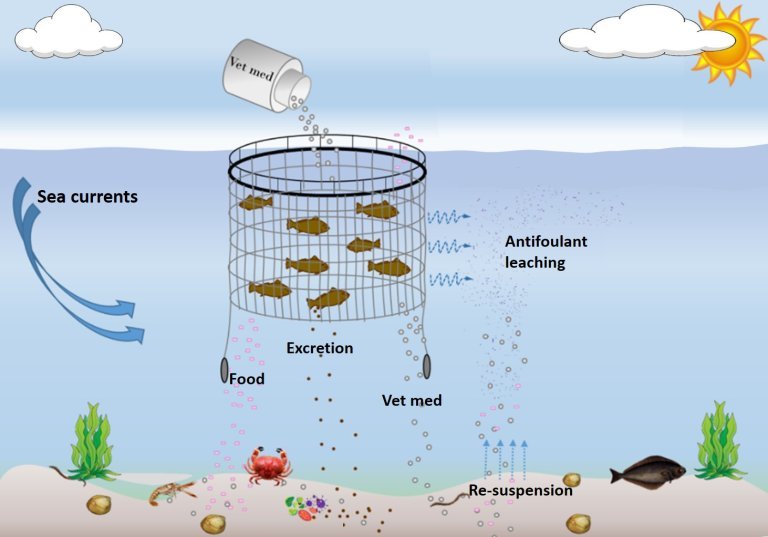Antivenom
ANTIfoulants, VEterinary MediciNal Products and Organic Material can affect marine sediment organisms, but to what extent?
About the project
The ANTIVENOM project will investigate whether the use of chemicals in aquaculture is having a significantly greater impact on the environment than previously considered, and if existing guidance on the assessment of risk is sufficient to cover specifically acting chemicals or the combined effects of multiple chemicals.
The project seeks to gain a greater understanding of the hazards and risks of current chemical use practices in aquaculture. The generated knowledge will serve as a basis for recommendations to improve effect and environmental risk assessments (ERAs) of veterinary medicines and antifoulants used in aquaculture to support future sustainable practices within the industry.
The project focuses on assessing the single and combined effects of chemicals, in combination with the contribution of organic matter, on non-target sediment organisms, using non-standard bespoke hazard assessment strategies. These strategies will be based on data gathered through the quantification (monitoring) and modelling of these chemicals to ensure realistic exposure scenarios.
It is envisaged that the science delivered through the ANTIVENOM project will support and influence policy makers on the changes necessary to improve ERA of chemicals used in aquaculture, and to ensure better protection and mitigation of the impacts to the marine environment from aquaculture practices. We will achieve this by bringing together an interdisciplinary team of experts. Specific outcomes will be to improve the regulatory frameworks and guidance documents for veterinary medicines and antifoulants, by proposing new sediment toxicity tests and testing requirements that are most relevant for the protection of northern European marine waters.
The involvement of key stakeholders from industry and government agencies within the project will aid in guiding the project to ensure a balance between scientific development, sustainability and regulatory, ethical, social and economic considerations.

Consortium: Description of research institutes, infrastructure and key personnel and roles within ANTIVENOM
NIVA
NIVA is Norway’s leading research institute for the aquatic environment, with access to state-of-the-art facilities in Oslo and unique large-scale facilities to perform micro and mesocosm experiments at the Oslo fjord marine field station.
Dr. Ailbhe Macken (PC, T2.2, T4.2) Research Manager, Oceanography. She is the GLP Deputy Manager and has many years of experience managing research projects and leading working groups for research funding agencies and industry.
Dr. Tânia Gomes (WP2, T2.1) Research scientist with extensive expertise in ecotoxicology and marine pollution, specialising in ecotoxicology, biomarker research and development, and environmental monitoring.
Dr. Malcolm Reid, Research Manager, Environmental Chemistry, expertise in environmental analysis, pharmaceutical, water sciences and epidemiology, responsible for all chemical analysis.
Prof. Anders Ruus, Senior research scientist specialising in sediment contaminants who holds a professor II position at the University of Oslo and will act as a co-supervisor for the PhD student.
Dr. Adam Lillicrap (WP4, T4.1) Research Manager, Ecotoxicology and Risk Assessment and NIVA GLP manager, Coordinator of JPI Oceans Knowledge Hub and member of EMA CVMP ERA WP.
Akvaplan-niva
Akvaplan-niva provides expert knowledge and advice on the environment and on aquaculture, integrating research, decision support and technical innovation.
Dr. Gro Refseth (T 1.1) Senior research scientist specialising in marine ecotoxicology and environmental risk assessment within the aquaculture industry.
Dr. Ole Anders Nøst (T 1.2) Senior scientist in physical oceanography. 25 years of experience managing research projects for agencies and industry.
Åkerblå
Åkerblå provide support, advice and guidance on performing site surveys, site extensions and are accredited to perform environmental surveys and provide expertise directed towards increased operational efficiency and environmentally sustainable aquaculture.
Dagfinn Breivik Skomsø is the Laboratory manager at Åkerblå and has extensive experience with performing field monitoring of fish farms and project management for benthic fauna analysis.
Wageningen Environmental Research (WEnR)
Wageningen Environmental Research (WEnR), Netherlands is a research institute which contributes by qualified and independent research towards environmental issues and has state of the art Micro and Mesocosm facilities which will be used directly in the project.
Prof. Paul van den Brink (T 2.3) has experience executing international projects on assessing the ecological effects of emerging contaminants, the development of effect models, traits based Ecological Risk Assessment and ecological risk assessment of chemicals.
Deltares
Deltares is an independent institute for applied research in the field of water and subsurface environments and a leading institute in the field of hydrodynamics and water quality modelling.
Dr. Frank Kleissen Senior researcher, he has experience in environmental assessments related to aquatic issues and hydrodynamic and water quality modelling of marine, estuarine and freshwater systems.
Dr Bert van Hattum Senior scientist environmental chemistry and ecotoxicology for over 30 years. Developed the MAMPEC model for exposure assessments of antifoulants.